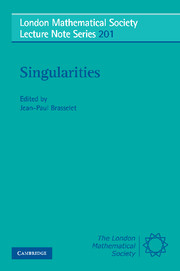Book contents
- Frontmatter
- Contents
- Introduction
- Plenary Conferences
- Specialized Conferences
- List of participants
- On Complex Projective Hypersurfaces which are Homology-Pn's
- Generic Geometry and Duality
- An arithmetical factorization for the critical point set of some map germs from C2 to C2
- Trivializations of stratified spaces with bounded differential
- Moduli for Singularities
- Conormal space and Jacobian modules: A short dictionary
- Weak Lefschetz and Topological q-Completeness
- Volumes and lattice points - proof of a conjecture of L. Ehrenpreis
- Connexions méromorphes
- Deformations of maps on complete intersections, Damon's Kv-equivalence and bifurcations
- Cycles évanescents et faisceaux pervers II: cas des courbes planes réductibles
- A Desingularization Theorem for Systems of Microdifferential Equations
- Topological Stability
- Boundary Fronts and Caustics and their Metamorphoses
- Quid des stratifications canoniques
- Irrégularité des revêtements cycliques
Conormal space and Jacobian modules: A short dictionary
Published online by Cambridge University Press: 05 May 2013
- Frontmatter
- Contents
- Introduction
- Plenary Conferences
- Specialized Conferences
- List of participants
- On Complex Projective Hypersurfaces which are Homology-Pn's
- Generic Geometry and Duality
- An arithmetical factorization for the critical point set of some map germs from C2 to C2
- Trivializations of stratified spaces with bounded differential
- Moduli for Singularities
- Conormal space and Jacobian modules: A short dictionary
- Weak Lefschetz and Topological q-Completeness
- Volumes and lattice points - proof of a conjecture of L. Ehrenpreis
- Connexions méromorphes
- Deformations of maps on complete intersections, Damon's Kv-equivalence and bifurcations
- Cycles évanescents et faisceaux pervers II: cas des courbes planes réductibles
- A Desingularization Theorem for Systems of Microdifferential Equations
- Topological Stability
- Boundary Fronts and Caustics and their Metamorphoses
- Quid des stratifications canoniques
- Irrégularité des revêtements cycliques
Summary
Introduction and historical ramblings
The present work comes after a long series of papers on equisingularity and stratification of analytic complex varieties. It is motivated by a recent attempt of T. Gaffney to extract, from inside the latest results, the essence of the old intuitions. He proceeds towards this goal by introducing in the equisingularity field a new mathematical tool : the integral closure of modules.
In his famous [Cargese] paper, Teissier considered the following situation: a family of (germs) of hypersurfaces in Cn with isolated singularities is given, together with a smooth subspace Y of the total space of the family X. He studied several kinds of equisingularity of this family
1. The Whitney equisingularity of X along Y, which insures, by Thom-Mather first isotopy lemma, the topological triviality.
It is easy to see that Whitney equisingularity is implied by saying certain derivatives are in the integral closure of the product of the jacobian ideal by the ideal of Y (this happened to be the condition w of Verdier)
The equidimensionality above Y of the exceptional divisor of the blowing up of the product of the jacobian ideal by the ideal of Y
The constancy of the different Milnor numbers of the plane sections of the fibres along Y
Teissier proved the equivalence of 2) and 3) and that these two implied 1). The inverse proposition, conjectured by him, was proved by Joel Briançpn and Jean-Paul Speder in their thesis ([B-S]) in 1975, thus achieving the completion of the dreamed dictionary in case of families of isolated singularities for analytic complex hypersurfaces.
Information
- Type
- Chapter
- Information
- Singularities , pp. 147 - 174Publisher: Cambridge University PressPrint publication year: 1994
Accessibility standard: Unknown
Why this information is here
This section outlines the accessibility features of this content - including support for screen readers, full keyboard navigation and high-contrast display options. This may not be relevant for you.Accessibility Information
- 7
- Cited by
